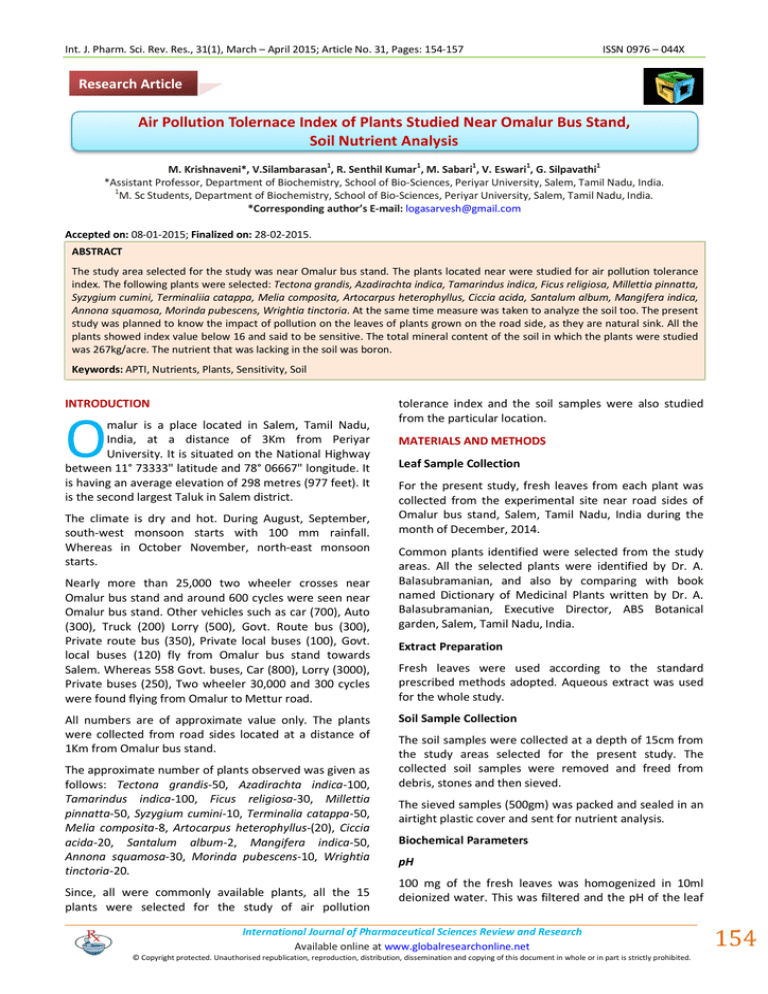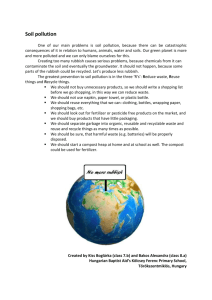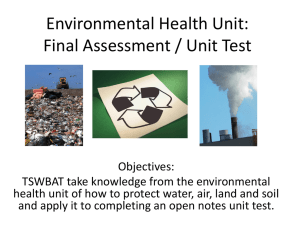Document 13310313
advertisement

Int. J. Pharm. Sci. Rev. Res., 31(1), March – April 2015; Article No. 31, Pages: 154-157 ISSN 0976 – 044X Research Article Air Pollution Tolernace Index of Plants Studied Near Omalur Bus Stand, Soil Nutrient Analysis 1 1 1 1 1 M. Krishnaveni*, V.Silambarasan , R. Senthil Kumar , M. Sabari , V. Eswari , G. Silpavathi *Assistant Professor, Department of Biochemistry, School of Bio-Sciences, Periyar University, Salem, Tamil Nadu, India. 1 M. Sc Students, Department of Biochemistry, School of Bio-Sciences, Periyar University, Salem, Tamil Nadu, India. *Corresponding author’s E-mail: logasarvesh@gmail.com Accepted on: 08-01-2015; Finalized on: 28-02-2015. ABSTRACT The study area selected for the study was near Omalur bus stand. The plants located near were studied for air pollution tolerance index. The following plants were selected: Tectona grandis, Azadirachta indica, Tamarindus indica, Ficus religiosa, Millettia pinnatta, Syzygium cumini, Terminaliia catappa, Melia composita, Artocarpus heterophyllus, Ciccia acida, Santalum album, Mangifera indica, Annona squamosa, Morinda pubescens, Wrightia tinctoria. At the same time measure was taken to analyze the soil too. The present study was planned to know the impact of pollution on the leaves of plants grown on the road side, as they are natural sink. All the plants showed index value below 16 and said to be sensitive. The total mineral content of the soil in which the plants were studied was 267kg/acre. The nutrient that was lacking in the soil was boron. Keywords: APTI, Nutrients, Plants, Sensitivity, Soil INTRODUCTION O malur is a place located in Salem, Tamil Nadu, India, at a distance of 3Km from Periyar University. It is situated on the National Highway between 11° 73333" latitude and 78° 06667" longitude. It is having an average elevation of 298 metres (977 feet). It is the second largest Taluk in Salem district. The climate is dry and hot. During August, September, south-west monsoon starts with 100 mm rainfall. Whereas in October November, north-east monsoon starts. Nearly more than 25,000 two wheeler crosses near Omalur bus stand and around 600 cycles were seen near Omalur bus stand. Other vehicles such as car (700), Auto (300), Truck (200) Lorry (500), Govt. Route bus (300), Private route bus (350), Private local buses (100), Govt. local buses (120) fly from Omalur bus stand towards Salem. Whereas 558 Govt. buses, Car (800), Lorry (3000), Private buses (250), Two wheeler 30,000 and 300 cycles were found flying from Omalur to Mettur road. All numbers are of approximate value only. The plants were collected from road sides located at a distance of 1Km from Omalur bus stand. The approximate number of plants observed was given as follows: Tectona grandis-50, Azadirachta indica-100, Tamarindus indica-100, Ficus religiosa-30, Millettia pinnatta-50, Syzygium cumini-10, Terminalia catappa-50, Melia composita-8, Artocarpus heterophyllus-(20), Ciccia acida-20, Santalum album-2, Mangifera indica-50, Annona squamosa-30, Morinda pubescens-10, Wrightia tinctoria-20. Since, all were commonly available plants, all the 15 plants were selected for the study of air pollution tolerance index and the soil samples were also studied from the particular location. MATERIALS AND METHODS Leaf Sample Collection For the present study, fresh leaves from each plant was collected from the experimental site near road sides of Omalur bus stand, Salem, Tamil Nadu, India during the month of December, 2014. Common plants identified were selected from the study areas. All the selected plants were identified by Dr. A. Balasubramanian, and also by comparing with book named Dictionary of Medicinal Plants written by Dr. A. Balasubramanian, Executive Director, ABS Botanical garden, Salem, Tamil Nadu, India. Extract Preparation Fresh leaves were used according to the standard prescribed methods adopted. Aqueous extract was used for the whole study. Soil Sample Collection The soil samples were collected at a depth of 15cm from the study areas selected for the present study. The collected soil samples were removed and freed from debris, stones and then sieved. The sieved samples (500gm) was packed and sealed in an airtight plastic cover and sent for nutrient analysis. Biochemical Parameters pH 100 mg of the fresh leaves was homogenized in 10ml deionized water. This was filtered and the pH of the leaf International Journal of Pharmaceutical Sciences Review and Research Available online at www.globalresearchonline.net © Copyright protected. Unauthorised republication, reproduction, distribution, dissemination and copying of this document in whole or in part is strictly prohibited. 154 © Copyright pro Int. J. Pharm. Sci. Rev. Res., 31(1), March – April 2015; Article No. 31, Pages: 154-157 extract was determined after calibrating pH meter with buffer solution pH 4 and pH 9. TCh (mg/g DW) was calculated as follows: ℎ = 0.1 × Relative Water Content Fresh weight was obtained by weighing the leaves. The leaf samples were then immersed in water over night blotted dry and then weighed to get the turgid weight. The leaves were then dried overnight in a hot air oven at 70°C and reweighed to obtain the dry weight. RWC was determined and calculated by the method as described 1 by Singh 1977. = ( ( ISSN 0976 – 044X ) × 100 ) − − Where: FW-Fresh weight, DW-Dry and TW-Turgid weight Ascorbic Acid Content ( ) ( ℎ ℎ ) × 100 Calculation of APTI The air pollution tolerance indices of the selected plants were determined by following the method of Singh and Rao 1983.4 The formula of APTI is given as: = [ ( + ) + ] 10 Where: A=Ascorbic acid content (mg/gm), T=Total chlorophyll (mg/gm), P=pH of the leaf extract, R=Relative water content of leaf (%). Analysis of Soil Nutrients Ascorbic acid content was measured by Titrimetric 2 method of Sadasivam 1987 using 2,6,dichlorophenol indo phenol dye. 500mg of leaf sample was extracted with 4% oxalic acid and then titrated against the dye until pink color develops. Similarly a blank is also developed. Total Chlorophyll Content For Total chlorophyll analysis, 0.5 g fresh leaf material was grounded and diluted to 10 ml in distilled water. A subsample of 2.5 ml was mixed with 10 ml acetone and filtered. Optical density was read at 645 nm (D645) and 663 nm (D663).3 Optical density of TCh (CT) is the sum of chlorophyll a (D645) density and chlorophyll b (D663) density as follows: = 20.2 ( 645) + 8.02 ( 663) The physio-chemical properties of soil were determined by following an alternative analytical indigenous technology developed by MCRC, IIT (M). Statistical Tool The Mean and Standard deviation (S) was calculated by using the following formula: = ( = ) ∑( ) RESULTS AND DISCUSSION The results of components involved in air pollution tolerance index assessment is shown in Table 1. Table 1: Air pollution tolerance index of plants studied near Omalur bus stand Name of the Plants pH Relative Water Content (%) Ascorbic Acid(mg/g) Chlorophyll (mg/g) APTI 1. Tectona grandis 9 ± 0.00 92.00 ± 0.00 0.13 ± 0.11 0.33 ± 0.07 11.62 ± 0.00 2. Azadirachta indica 6 ± 0.00 66.85 ± 0.00 0.20 ± 0.09 0.27 ± 0.26 7.54 ± 0.00 3. Tamarindus indica 4 ± 0.00 54.06 ± 5.92 0.19 ± 0.05 0.31 ± 0.30 7.22 ± 2.04 4. Ficus religiosa 8 ± 0.00 75.21 ± 0.00 0.38 ± 0.24 0.33 ± 0.14 8.34 ± 0.00 5. Millettia pinnatta 7 ± 0.00 76.31 ± 2.70 0.19 ± 0.12 0.54 ± 0.15 8.90 ± 0.64 6. Syzygium cumini 4 ± 0.00 77.19 ± 0.00 0.19 ± 0.05 0.18 ± 0.07 8.13 ± 0.00 7. Terminalia catappa 7 ± 0.00 77.49 ± 7.13 0.16 ± 0.09 0.30 ± 0.12 8.39 ± 0.35 8. Melia composita 6 ± 0.00 52.74 ± 1.55 0.19 ± 0.05 0.50 ± 0.13 6.62 ± 0.53 9. Artocarpus heterophyllus 6 ± 0.00 79.32 ± 0.03 0.13 ± 0.11 1.31 ± 0.15 8.46 ± 0.24 10. Ciccia acida 7 ± 0.00 73.70 ± 12.75 0.25 ± 0.10 0.36 ± 0.09 8.47 ± 0.44 11. Santalum album 7 ± 0.00 80.50 ± 0.04 0.26 ± 0.14 0.93 ± 0.19 9.91 ± 1.09 12. Mangifera indica 7 ± 0.00 83.07 ± 9.57 0.19 ± 0.05 0.98 ± 0.20 9.58 ± 0.00 13. Annona squamosa 7 ± 0.00 63.12 ± 6.98 0.10 ± 0.06 0.79 ± 0.04 6.81 ± 0.82 14 Morinda pubescens 7 ± 0.00 36.05 ± 3.04 0.20 ± 0.12 1.0 ± 0.21 4.83 ± 0.68 7 ± 0.00 70.75 ± 5.75 0.17 ± 0.08 0.33 ± 0.11 7.81 ± 0.27 S. No. 15 Wrightia tinctoria Values are Mean ± SD for three experiments International Journal of Pharmaceutical Sciences Review and Research Available online at www.globalresearchonline.net © Copyright protected. Unauthorised republication, reproduction, distribution, dissemination and copying of this document in whole or in part is strictly prohibited. 155 © Copyright pro Int. J. Pharm. Sci. Rev. Res., 31(1), March – April 2015; Article No. 31, Pages: 154-157 Air Pollution Tolerance Index ISSN 0976 – 044X Table 2: Normal Nutrient Values The pH content was found to be alkaline for most of the plants selected for the study, whereas acidic pH was observed with Tamarindus indica, Syzygium cumini. pH observed was similar in the work reported by Krishnaveni for Ficus religiosa, Azadirachta indica, Syzygium cumini.5 Annona squamosa,9 Morinda pubescens9. The relative water content observed was found to be high with Tectona grandis and moderate with rest of the plants studied. Similar result was reported by Krishnaveni for Mangifera indica,6 Tectona grandis,7 Ficus religiosa10 with respect to relative water content. Ascorbic acid content was higher with Ficus religiosa and moderate amount of ascorbic acid was observed with remaining plants. Ascorbic acid obtained was similar to the result reported 10,13 by Krishnaveni for Ficus religiosa, Terminalia 11 catappa, . The chlorophyll content was high with Artocarpus heterophyllus, Morinda pubescens. Similar result was observed was reported by Krishnaveni with chlorophyll for Ficus religiosa,6 Azadirachta indica,8 Millettia pinnatta,10 Tectona grandis12. Nutrient Low Medium High N (Kg/acre) <113 113-182 >182 P (Kg/acre) <18 18-36 >36 K (Kg/acre) <60 60-138 >138 OC (%) <0.75 0.75-1.5 >1.5 Mg (mg/kg) <10 10-15 >15 HA (Kg/Acre) <18 18-31 >31 Iron (mg/kg) <6 6-8 >8 Mn (mg/kg) <1 1.2-2.5 >2.5 Cu (mg/kg) <0.3 0.3-1 >1 Zn (mg/kg) <0.5 0.5-1 >1 Sulphur (mg/kg) 0-10 10-15 >15 Ca (mg/kg) <300 (Deficient) >300(Sufficient) - Boron (mg/kg) <0.5 (Deficient) >0.5(Sufficient) - Molybdenum (mg/kg) <0.2 (Deficient) >0.2(Sufficient) - Table 3: Results of soil samples collected near road sides of Omalur bus stand The air pollution tolerance index observed was high for Tectona grandis whereas Morinda pubescens showed lower air pollution tolerance index. S. No. Nutrients Results 1. pH 7.95 2. EC 0.26 The pollution tolerance index was found to decrease in the following order: Tectona grandis 11.62 ± 0.00, Santalum album 9.91 ± 1.09, Mangifera indica 9.58 ± 0.00, Millettia pinnatta 8.90 ± 0.64, Cicca acida 8.47 ± 0.44, Artocarpus heterophyllus 8.46 ± 0.24, Terminalia catappa 8.39 ± 0.35, Ficus religiosa 8.34 ± 0.00, Syzygium cumini 8.13 ± 0.00, Wrightia tinctoria 7.81 ± 0.27, Azadirachta indica 7.54 ± 0.00, Tamarindus indica 7.22 ± 2.04, Annona squamosa 6.81 ± 0.82, Melia composita 6.62 ± 0.53, Morinda pubescens 4.83 ± 0.68. (Table 1). Similar result was reported by Krishnaveni for Tectona grandis,7,13 Millettia pinnatta,10 Ficus religiosa,11 Tamarindus indica,11 Morinda sp.,12 Terminalia catappa14. 3. Organic Carbon (%) 0.62 4. Nitrogen (Kg/acre) 129.87 5. Phosphorus (Kg/acre) 8.33 6. Potassium (Kg/acre) 128.8 7. Calcium (mg/kg) 501.88 8. Magnesium (mg/kg) 160.28 9. Sodium (mg/kg) 135.13 10. Iron (mg/kg) 5.38 11. Manganese (mg/kg) 4.75 12. Copper (mg/kg) 1.4 13. Zinc (mg/kg) 0.62 14. Boron (mg/kg) - The obtained APTI value of each plants were categorized 15 according to Kalyani and singaracharya, 1995. The following are the four categories APTI index range < 1= > very sensitive, 1 to 16 => Sensitive, 17 to 29 => Intermediate and 30 to 100 => Tolerant. Based on this classification system, the plants were categorized as sensitive, very sensitive, intermediate, tolerant etc. In our study area, all the plants assessed were found to be sensitive as it exhibits APTI values in the range of 1 to 16. Soil Nutrient Analysis The results of nutrient present in the soil are depicted in Table 3 whereas Table 2 depicts the normal nutrient values of soil. 15. Sulfate (mg/kg) 10.32 16. Humus (mg/kg) 100.55 Total minerals (kg/acre) 267 The results of nutrient contents are expressed in Table 3. The soil sample collected near road sides of Omalur bus stand shows pH of 7.95 and its electrolyte conductivity, organic carbon was 0.26 and 0.62%. The major nutrients present are nitrogen 129.87kg/acre, phosphorus 8.33kg/acre, potassium 128.8kg/acre. Minor nutrients present are as follows: Calcium 501.88mg/kg, Magnesium 160.28mg/kg, Sodium 135.13mg/kg, Iron 5.38mg/kg, Manganese 4.75mg/kg, Copper 1.4mg/kg, Zinc 0.62 mg/kg, Sulfate 10.32mg/kg. The Total mineral content present in the soil sample collected from the study area was 267kg/acre. The Humus content of the soil was International Journal of Pharmaceutical Sciences Review and Research Available online at www.globalresearchonline.net © Copyright protected. Unauthorised republication, reproduction, distribution, dissemination and copying of this document in whole or in part is strictly prohibited. 156 © Copyright pro Int. J. Pharm. Sci. Rev. Res., 31(1), March – April 2015; Article No. 31, Pages: 154-157 ISSN 0976 – 044X 100.55mg/kg. Among the major minerals studied, nitrogen, potassium was higher in concentration. Among the minor minerals studied, calcium was found in higher concentration. Next to calcium, magnesium, sodium was found in higher amount. Boron was completely absent in the soil collected from the study area. When compared to normal nutrient content table (Table 3), the nitrogen and potassium was found to be medium, and other nutrients were present in sufficient amount. Whereas the phosphorus and iron content was low in the studied soil sample. Soil test is performed to determine the fertility of the soil. The plant growth is determined not only by the fertilizer added but also on the properties of soil. pH of soil, organic matter present in soil are essential factors in influencing the availability of nutrients as well as aids soil structure. The results of present study are well correlated with the results reported by Krishnaveni for the following: Total mineral content of the soil was similar to that of soil sample studied near new bus stand.16 The copper content of the studied soil sample was similar to the result assessed from Thoppur hill area.17 The zinc content of the soil sample studied was similar to the result of soil samples collected from Thoppur, Hasthampatty, Yercaud.16-18 4. Singh SK, Rao DN, Evaluation of plants for their tolerance to air pollution, In: Proceedings Symposium on Air Pollution Control, Indian Association for Air Pollution Control, 1, 1983, 218-224. 5. Krishnaveni M, Chandrasekar R, Amsavalli L, Madhaiyan P, Durairaj S, Air pollution tolerance index of plants at Perumalmalai Hills, Salem, Tamil Nadu, India, International Journal of Pharmaceutical Sciences Review and Research, 20(1), 2013, 234-239. 6. Krishnaveni M, Amsavalli L, Chandrasekar R, Durairaj S, Madhaiyan P, Biochemical changes in medicinal plant leaves as a biomarker of pollution, Research journal of pharmacy and technology, 6(5), 2013, 537-543. 7. Krishnaveni M, Madhaiyan P, Durairaj S, Chandrasekar R, Amsavalli L, Pollution induced changes in plants located at Chinnatirupathi, Salem, Tamil Nadu, India, International Journal of Pharmaceutical Sciences and Research, 4(8), 2013, 3192-3195. 8. Krishnaveni M, Durairaj S, Madhiyan P, Amsavalli L, Chandrasekar R, Impact of air pollution in plants near Thermal Power Plant Mettur, Salem, Tamil Nadu, India, International Journal of Pharmaceutical Sciences Review and Research, 20(2), 2013, 173177. 9. Krishnaveni M, Biochemical changes in plants indicating air pollution, International Journal of Pharmacy and Pharmaceutical Sciences, 5(3), 2013, 585-586. CONCLUSION 11. Krishnaveni M, Magesh P, Air pollution tolerance index induced by The air pollution tolerance index was studied for the 15 plants available in the particular locality i.e near Omalur bus stand. All the plants assessed were classed as sensitive to pollution. The tolerance, sensitivity of the plants depend on aspects like age and growth of plant a factor which is dependent on the nutrients present in the soil, seasonal variation, nature of pollution, increased access to a particular type of pollutant etc. Acknowledgement: The author wishes her thanks to Honorable Vice-chancellor Dr. C. Swaminathan Avl, and Registrar Dr. K. Angamuthu Avl, Periyar University, Salem for their administrative support and excellent infrastructure facilities provided and also Coordinator, School of Bio-Sciences, Periyar University, Salem-11, Dr. A. Balasubramanian, ABS Botanical Garden, Salem for his help in identifying plants, Shri AMM Murugappa Chettiar Research centre, Taramani, Chennai, for their help in analyzing samples. The author would like express her gratitude to her dedicated teachers. REFERENCES 1. Singh A, Practical Plant Physiology, Kalyari Publishers, New Delhi, 1977. 2. Department of Biology, East China Normal University, Experiment instruction of plant physiology. People’s Education Press, 1980. 3. Sadasivam S, Theymdli Balasubraminan, In: Practical Manual in Biochemistry Tamil Nadu Agricultural University, Coimbatore, 1987, 14. 10. Krishnaveni M, Lavanya K, Air pollution tolerance index of plants – A comparative study, International Journal of Pharmacy and Pharmaceutical Sciences, 6(5), 2014, 320-324. biochemical components in plants, International Journal of Pharmacy and Pharmaceutical Sciences, 6(5), 2014, 362-364. 12. Krishnaveni M, Ponraj K., Lavanya K, Magesh P, Kalimuthu R, Jasbin Shyni G, Plants as biomarker of pollution –a study on Thoppur hill road side plants, Dharmapuri, Tamil Nadu, India., International Journal of Pharmaceutical Sciences Review and Research, 26(2), 288-291. 13. M. Krishnaveni M, Kalimuthu R, Ponraj K, Lavanya K, Magesh P, Jasbin Shyni G, Air pollution tolerance assessment of Yercaud road side plants, International Journal of Pharmaceutical Sciences Review and Research, 26(2), 2014, 177-181. 14. Krishnaveni M, Jasbin Shyni George, Comparative study on APTI, antioxidant status of plants & soil health, Lambert academic publishing, ISBN: 978-3-659-52656-5, 2014, 1-90. 15. Kalyani Y, Singacharya MA, Biomonitoring of air pollution in Warangal city, Andhra Pradesh, Acta Botanica Indica, 23, 1995, 2124. 16. Krishnaveni M, Magesh P, Lavanya K, Kalimuthu R, Ponraj K, Jasbin Shyni G, Analysis of nutrients collected near road sides of new bus stand, Salem, Tamil nadu, India, Research journal of pharmacy and technology, 7(6), 2014, 663-664. 17. Krishnaveni M, Ponraj K, Kalimuthu R, Lavanya K, Magesh P, Jasbin Shyni G, Assessment of nutrients for soil samples collected near roadsides of Thoppur hill, Salem, Tamil Nadu, India., Research journal of pharmacy and technology, 7(6), 648-649. 18. Krishnaveni M, Kalimuthu R, Ponraj K, Magesh P, Lavanya K, Jasbin Shyni G, Nutrient analysis of soil samples collected from Yercaud road, Salem district, Tamil Nadu, India. International Journal of Pharmaceutical Sciences Review and Research, 26(1), 2014, 216217. Source of Support: Nil, Conflict of Interest: None. International Journal of Pharmaceutical Sciences Review and Research Available online at www.globalresearchonline.net © Copyright protected. Unauthorised republication, reproduction, distribution, dissemination and copying of this document in whole or in part is strictly prohibited. 157 © Copyright pro






